In the Weird War of Konflikt ’47 (K47), the introduction of Rift-tech revolutionised a great many areas of 1940s warfare, and airborne troops were no exception, despite being a relatively recent innovation themselves. Today, we’re taking a deep dive into the history, rules, and usage of these high-tech soldiers as they descend from on high to the tabletop battlefields of K47! Get ready… it’s a long way down!
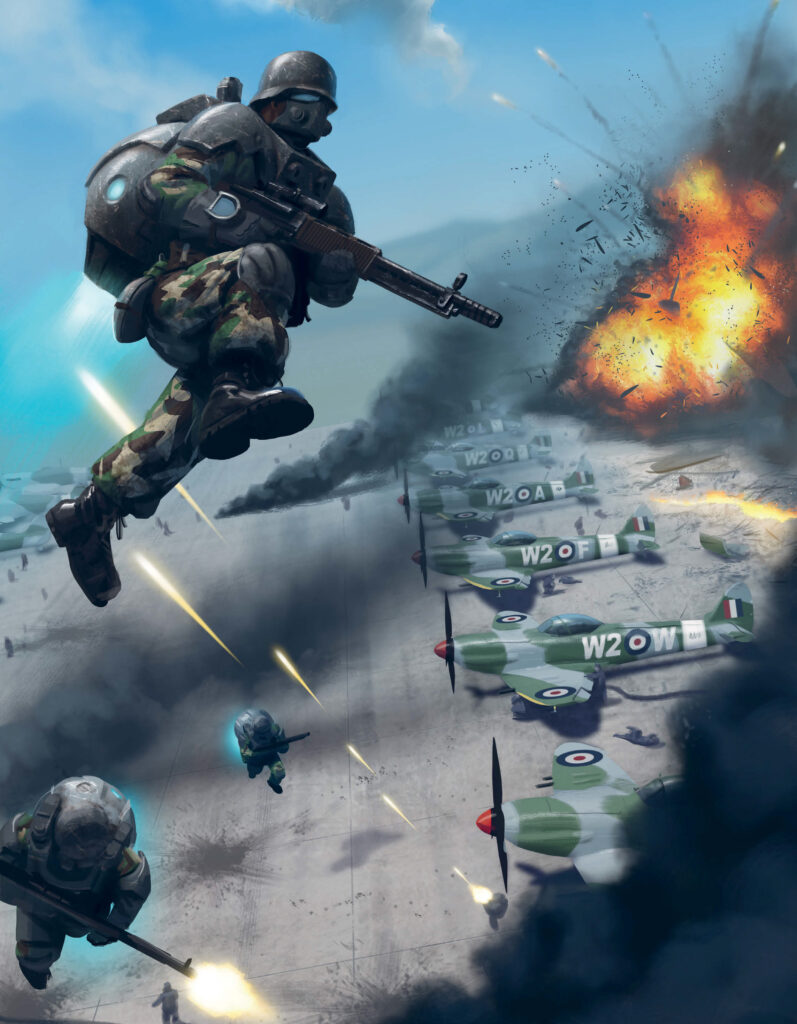
The German military, historically an early adopter of parachutists, was the first to seize upon the potential for Rift-tech to improve airborne operations. Deploying troops via the traditional ‘static line’ parachute drop had a number of significant limitations, namely the relatively long time of descent, during which time the soldiers had very little control over where they would end up, and the tendency of this (and factors such as weather conditions and navigational errors) to lead to very ‘scattered’ dropsites, requiring troops to spend a large amount of time regrouping and reforming before they could proceed with their objectives. Conventional parachutes also restricted the amount and weight of equipment each man could carry, and were liable to cause serious issues and injuries if the unfortunate paratrooper landed on rough ground or in (even more dreaded) thick woodlands. Seeking ways to ameliorate these issues, German scientists developed what would become known as Falcon armour. Based on the prototype Panzerharnisch 46 Ausf. B heavy armour technology, Falcon was significantly lighter, protecting only the torso, but mounted and powered an experimental repulsorlift motor. This allowed the soldier to control his rate of descent and guide his flightpath far more effectively than a parachute when jumping from an aircraft and also gave him the ability to soar above the battlefield in huge leaping bounds – while not true flight, this provided massively increased mobility and the ability to bypass almost any obstacle. With final testing still underway, the Herman Goring division (always keen to have the newest, shiniest equipment!) deployed a small force of Falcon-equipped Fallschirmjäger in a series of decapitation strikes against Soviet command posts north of Warsaw in October 1946 as part of Unternehmen Walhalla (Operation Valhalla). The success of these raids (allegedly masterminded by Otto Skorzeny) prompted the Luftwaffe to order Falcon into mass production, standing up the 5th and 6th Parachute Divisions with the new equipment en masse in early 1947.
With the resurgence of the Fallschirmjäger adding a new dimension to the German war machine, their Axis partners were keen to receive this new technology. With the demand for Falcon, however, German industry was unable to meet all of these requests, and the armour was initially rolled out only in limited quantities to certain elite elements of the Italian National Republican Army (ENR). These formations, known as Falco, were heavily mentored by German officers, and equipped with a mixture of German and Italian equipment. Few in number, they were nevertheless the preferred choice for audacious raids behind Allied lines, and earned a justifiably fearsome reputation. Later in 1947, an even smaller amount of Falcon armour was supplied in secret to Finland, equipping a single unit of Jääkäri light infantry who used it to good effect in striking at Soviet infrastructure before vanishing into the snow-covered woodlands. Given the success of these formations, it seems certain that the rollout will continue across the Axis powers.
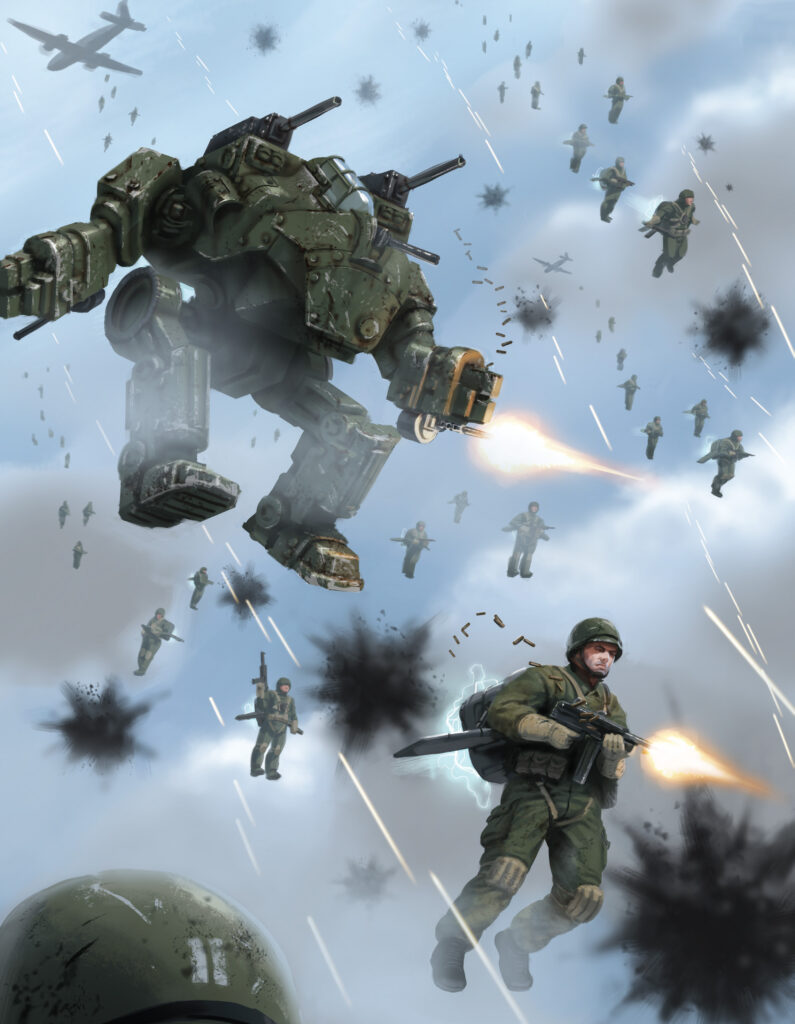
While all of this was occurring, the Allies were of course not standing by idly. Recognising the same issues as their German counterparts, US scientists embarked on Project Firefly, arriving at a very similar end via a different route. Rather than basing their concept around existing heavy armour technology, the Americans produced a smaller backpack-mounted repulsorlift, featuring manoeuvering winglets for improved flight control. This allowed for cheaper and faster mass production, and the M1 Firefly jump packs (more properly the Repulsorlift, Personnel, M1) were soon undergoing field trials with elite units of the 82nd and 101st Airborne Divisions. Initial reports were promising, and in March 1947 a hand-picked team from the 502nd Parachute Infantry Regiment launched a daring raid on Bremerhaven, sinking U-3008 and killing its commander, Ludwig Ditmar. While casualties were severe, this was considered sufficient grounds to begin mass deployment, and the new 11th and 17th Airborne Divisions were hastily converted mid-assembly into Firefly formations, being deployed to the Pacific and European theatres, respectively. Deployed much as their conventional parachute-equipped brethren initially, the Firefly-equipped paratroopers would go on to serve as ultra-mobile rapid reaction forces, striking wherever the enemy was weakest and shoring up defences against counterattacks.
Interestingly, despite being offered the technology under the Lend-Lease program, Britain displayed little interest in Firefly, preferring to deploy its vaunted Airborne troops via more conventional means. Rumours of the elite SAS utilising the technology are wholly unconfirmed, and certainly the project seems to have been given short shrift among Commonwealth forces, with the British preferring to concentrate on their development of artifical intelligence. The co-belligerent Italian forces, however, were eager adopters of the equipment and were soon engaging in vicious battles with their Fascist counterparts. Free French forces (by this stage fully equipped in the American style) also made good use of Firefly, with the famed 2nd Parachute Chasseur Regiment fully converted by mid-1947.
On the Table
Jump Pack infantry provide a fantastic new tactical dimension to games of Konflikt ‘47. Veteran players of Bolt Action and K47 footsloggers alike well know the value of terrain for slowing and obstructing enemy units – units with the Flight rule simply ignore terrain (so long as they don’t end their movement in impassable terrain)! With a 12” Advance and 18” Run, they’re ultra-mobile, able to redeploy to where they’re most needed in a heartbeat, and capable of appearing from seemingly nowhere to menace enemy units. Across the nations that deploy them, the profiles tend to be fairly similar – Veterans, packing a lot of assault rifles or SMGs. The heavier Falcon armour lends its wearers the Resilient special rule, meaning they only die on a 6+ to shooting, while the less-encumbering M1 Firefly jump packs allow for the carriage of heavier weaponry – rift-tech grenade launchers for Italian users, and the frankly terrifying option to take a flamethrower in US units! They make for perfect strike units, able to get in close, lay down a barrage of point-blank firepower, and get out quickly, and are often best used by holding them back in reserve, waiting for your enemy to commit their forces. They do cost a lot of points, though, so make sure not to waste them!
Strap on your repulsorlift and get ready – it’s time to bring death from above!
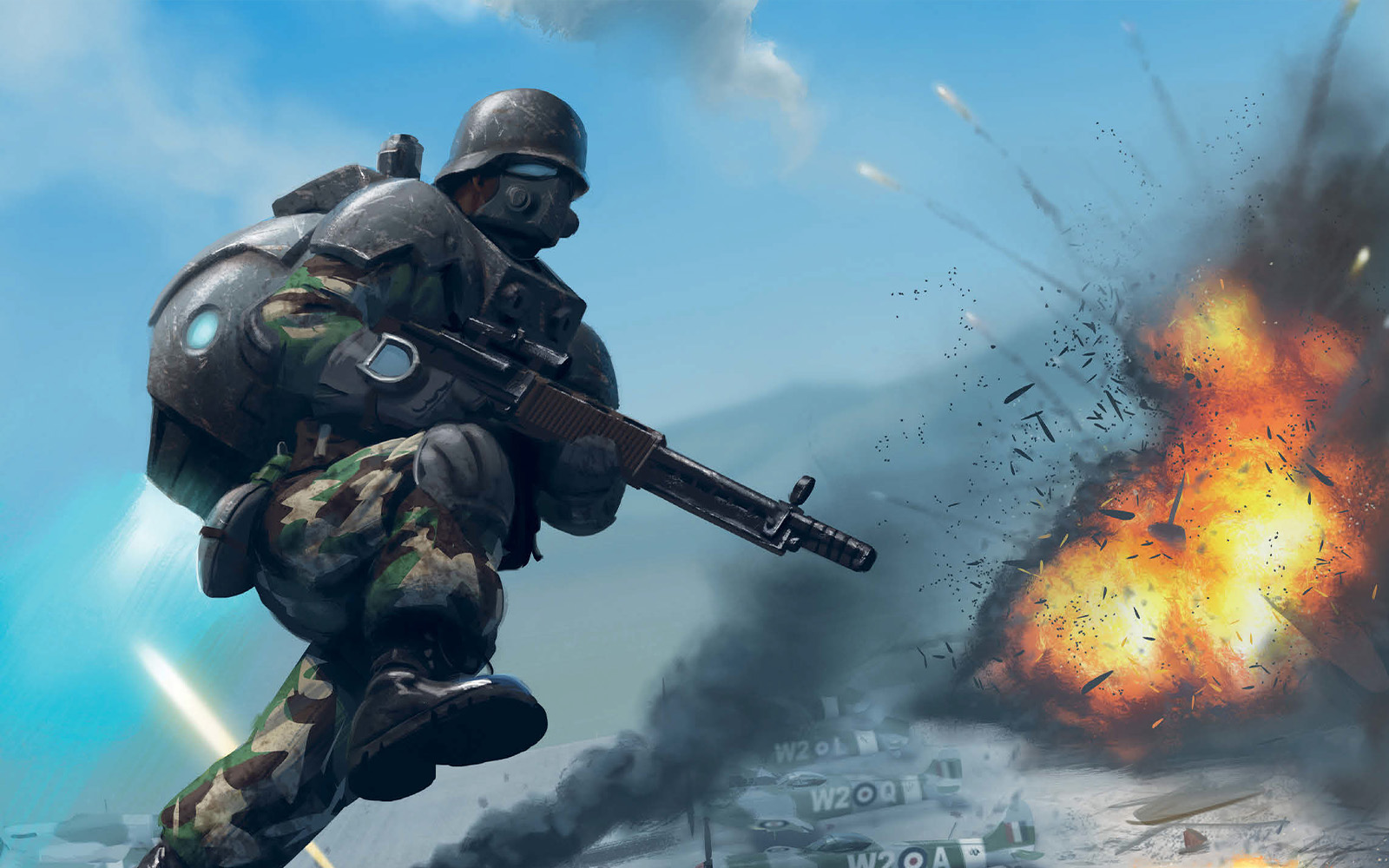
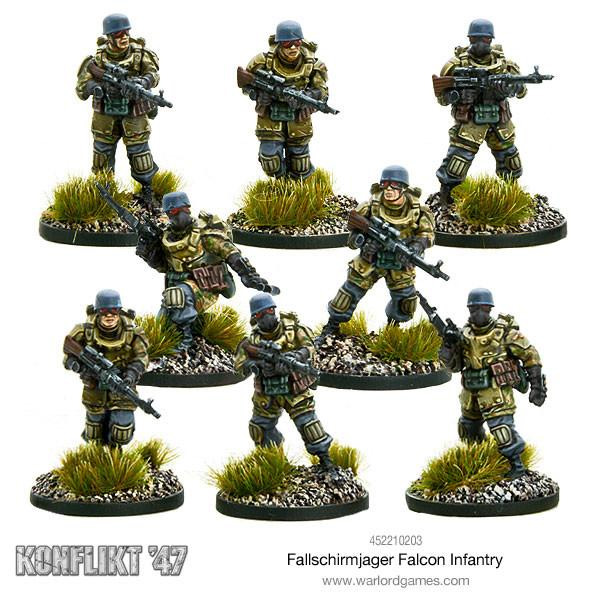
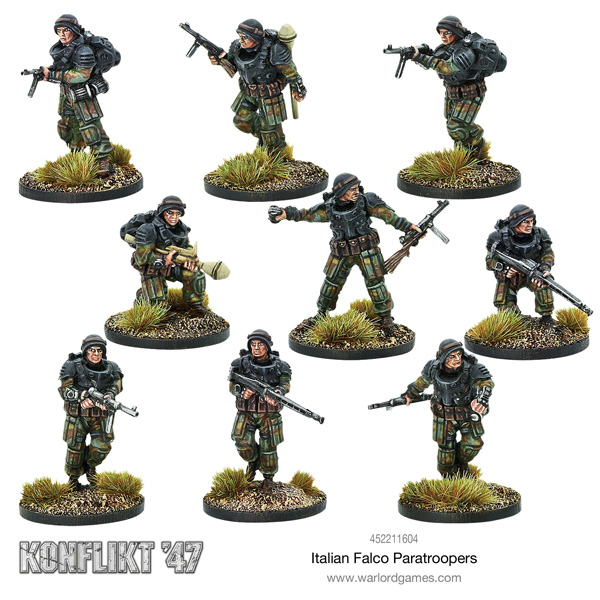
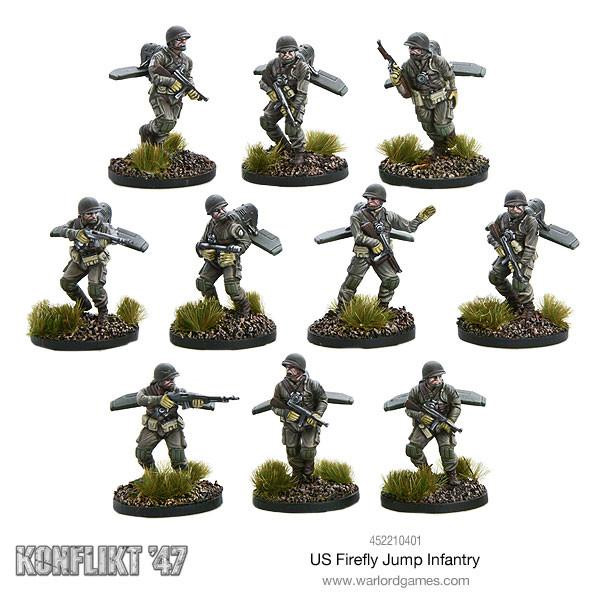
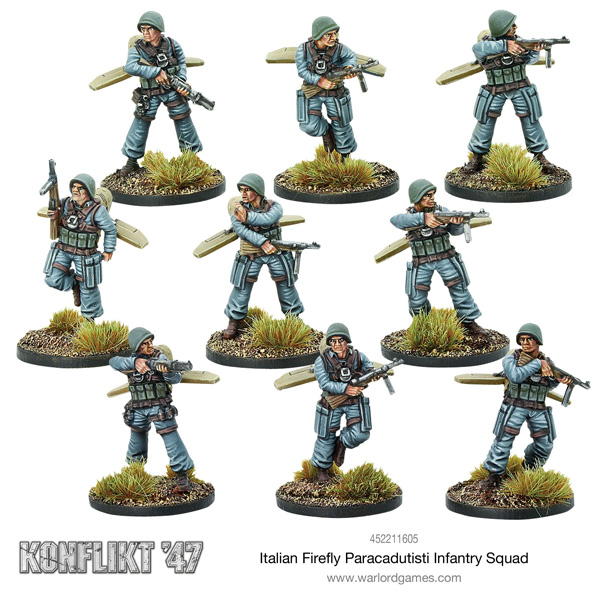
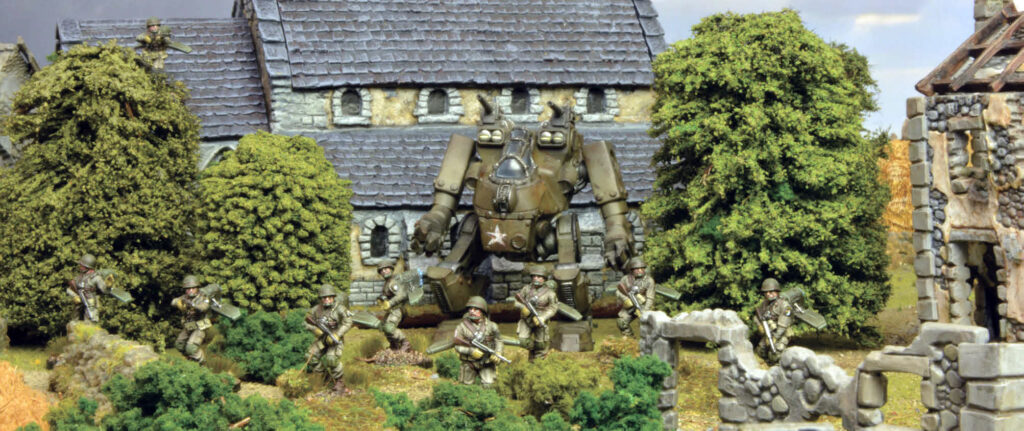
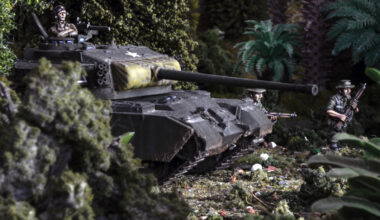
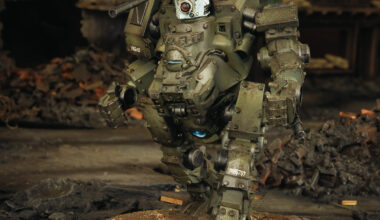
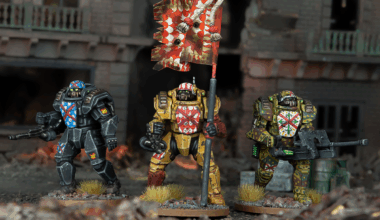
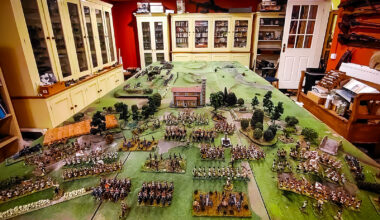
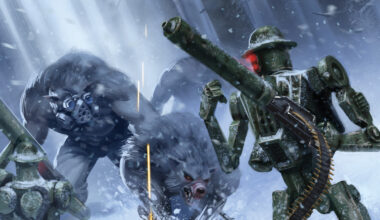
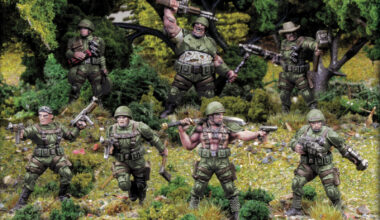
4 comments
Thats cool and all, but when can we expect reasonably priced tanks and actual NEW content for this long dead franchise?
Great article. These troops would be more versatile if they were given the elite rule as without support from jumping armour in support they can get exposed very quickly.
My idea is to team my Falcon fallschirmjaeger up with Nachtjaeger and the Heuschrecke. That way everything has “Flight”….
One of my pet peeves with Bolt Action/Konflikt 47 is that the German fallschirmjager continue to get screwed over their FG42s. The FG42 fires a full power rifle cartridge, is selective fire and has an integral bipod. It is NOT an assault rifle, it is an automatic rifle, just like a BAR. Is there anyone at Warlord Games that has a working knowledge of firearms? How ’bout helpin’ out the poor fallschirmjager….
Comments are closed.